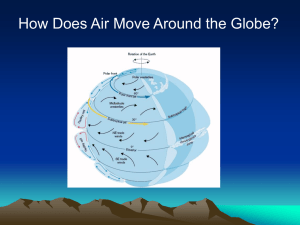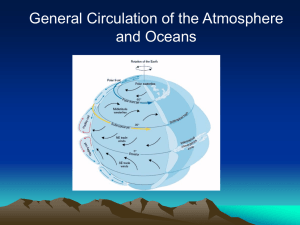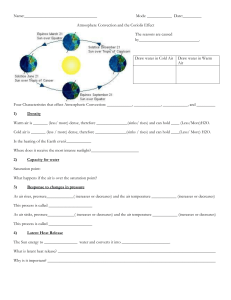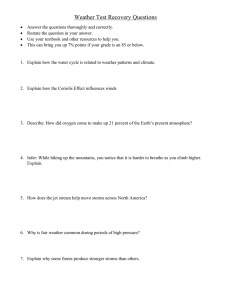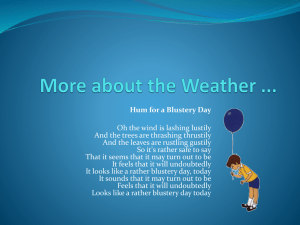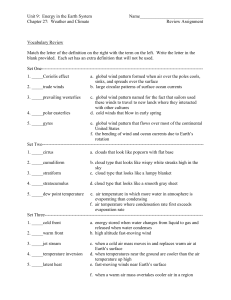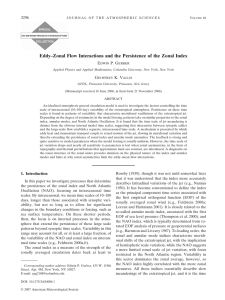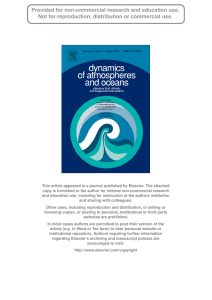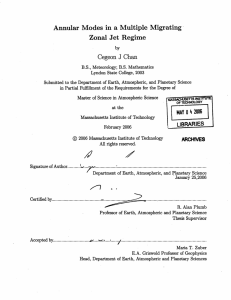Understanding Weather and Climate Ch 8
advertisement
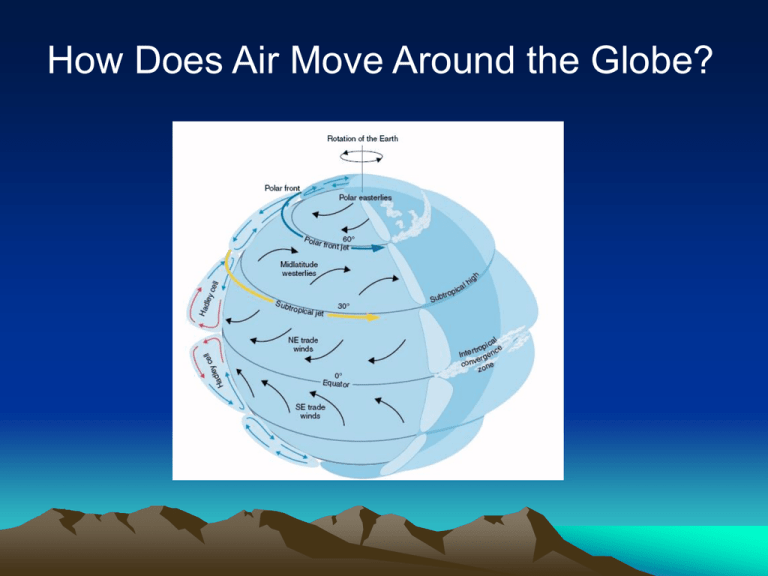
How Does Air Move Around the Globe? Review of last lecture • Know 3 Forces that affect wind speed /direction • Especially work on Coriolis force, as this is the hardest to understand. Which direction is air deflected to by Coriolis force? • What is the geostrophic balance? At which level is it valid? Difference between upper level and surface winds • Troughs, ridges, cyclones and anticyclones. Do they correspond to high or low surface pressure? Is the air moving clockwise or counter-clockwise around them? The most common atmospheric circulation structure CE H L Cooling or No Heating Heating Friction H L CE Imbalance of heating Imbalance of temperature Imbalance of pressure Wind Introduction • Well-defined heating, temperature and pressure patterns exist across the globe • These define the general circulation of the planet • In describing wind motions: – Zonal winds (east-west): flow parallel to lines of latitude • Flowing eastward: Westerly wind • Flowing westward: Easterly wind – Meridional winds (north-south): flow parallel to lines of longitude • Flowing northward: Southerly wind • Flowing southward: Northerly wind Annual mean precipitation (heating) Extratropical stormtrack Tropical rainfall Extratropical stormtrack Primary Highs and Lows Equatorial low Subtropical high Subpolar low Polar high Three-cell model Zonal mean circulation Each hemisphere is divided into 3 distinct cells: Hadley Cell Ferrel Cell Polar Cell Vertical structure and mechanisms Polar Cell (thermal): Driven by heating at 50 degree latitude and cooling at the poles Ferrel Cell (dynamical): Dynamical response to Hadley and polar cells Polar Hadley Hadley Cell (thermal): Heating in tropics forms surface low and upper level high air converges equatorward at surface, rises, and diverges poleward aloft descends in the subtropics High pressure: warm surface temperature, drought and desert Global distribution of deserts (all near high pressure cells) Zonal mean structure of temperature Two characteristics: • Horizontally uniform in the tropics • Steep gradient in the extratropics Zonal mean structure of zonal wind Two characteristics: • Westerly winds in the extratropical troposphere • Jet streams: local maximum of winds Westerly winds in the extratropical troposphere • The existence of the upper level pressure gradient air is being pushed toward poles Coriolis effect deflects upper air (to the right) Westerlies dominate upper troposphere • Strongest during winter thermal gradient is large • Explains why storms move eastward, flight times The Jet Streams • Caused by steep temperature gradients between cold and warm air masses • Polar front - marks area of contact, steep pressure gradient polar jet stream • Low latitudes subtropical jet stream • Stronger in winter, affect daily weather patterns A Jet Stream seen from satellite The subtropical jet is seen as a band of clouds extending from Mexico on an infrared satellite image Video: The jet streams General circulation of the oceans • Ocean surface currents – horizontal water motions • Transfer energy and influence overlying atmosphere • Surface currents result from frictional drag caused by wind - Ekman Spiral • Water moves at a 45o angle (right) in N.H. to prevailing wind direction • Due to influence of Coriolis effect • Greater angle at depth Global surface currents • Surface currents mainly driven by surface winds • North/ South Equatorial Currents pile water westward, create the Equatorial Countercurrent • western ocean basins –warm poleward moving currents (example: Gulf Stream) • eastern basins –cold currents, directed equatorward Summary • Three precipitation (heating) belts. Primary high and lows • Three-cell model. Mechanism for each cell • Surface low pressure is associated with clouds and precipitation. Surface high pressure is associated with warm surface temperature, drought, and desert. • Two characteristics of zonal mean temperature structure • Two characteristics of zonal mean wind structure. Why does westerly winds prevail in the extratropical troposphere? What cause the jet streams? • What drives the ocean surface currents? In the case of Ekman spiral, what is the direction of surface current relative to surface wind? Works cited Images •http://pulleysandgears.weebly.com/gears.html •http://visual.merriamwebster.com/earth/meteorology/meteorological-measuringinstruments/measure-wind-direction.php
